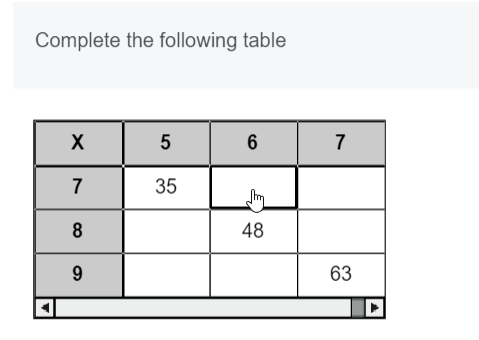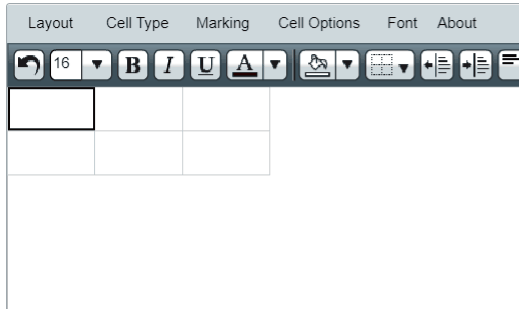Creating a Table (Legacy) question
A Table (Legacy) question lets candidates submit a data grid in response to a prompt. You can either provide a partially-filled table or give candidates the tools to create their own.

This article explains how to create a basic Table (Legacy) question in Surpass and includes information on formatting options and cell marking.
In This Article
1. Choose your item type
In your subject, select Create New Item to open the Question Types menu. Choose Table to create a blank Table (Legacy) item and go to the Edit screen.

2. Name your item
Enter the item’s name in the Name field.

3. Enter your question text
Enter your question text in the question stem. Select Add Text Area to add an additional question stem. You can have a maximum of five question stems per item.

Open Additional Options to add source material, assistive media, or a table to your question stem.
4. Edit and populate your table

Table (Legacy) items contain a configurable 2 x 3 data grid that accepts both alphabetical and numerical content. Use the table toolbar to format your table and add or remove cells. Full details on settings are table in ‘Table toolbar options’ later in this article.
You can set up your table with any combination of the following cell types:
| Cell type | Description |
|---|---|
| Static Text | Contents are locked at the point of item creation. Candidates cannot interact with Static Text cells. |
| Input Text | Candidates can enter alphanumerical content. For computer-marked Table items, enter the correct response here. This value is not visible to candidates. |
| Input Text (Numbers Only) | Candidates can enter numerical content. Alphabetical characters do not register in Input Text (Numbers Only) cells. For computer-marked Table items, enter the correct response here. This value is not visible to candidates. |
| Auto Sum | Contents are dynamically calculated from the numbers in cells about the Auto Sum cell. Auto Sum cells cannot read numbers in Static Text and Input Text cells with alphabetical characters. |
Highlight a cell and select Cell Type to change its type.

Table (Legacy) toolbar options
Expand the following sections to see definitions of each setting on the table toolbar.
| Setting | Description |
|---|---|
| Add Row Below | Inserts a new row beneath the selected cell. |
| Add Column Right | Inserts a new column to the right of the selected cell. |
| Delete Row | Deletes the selected row and its contents. |
| Delete Column | Deletes the selected column and its content. |
| Row Height | Sets the height of the selected row in pixels. You can apply this value to all rows. |
| Column Width | Sets the width of the selected column in pixels. You can apply this value to all columns. |
| Setting | Description |
|---|---|
| Merge Cells | Combines the selected cells into one cell. |
| Split Cells | Divides merged cells. |
| Decrease Indent | Moves text in selected cells one pixel to the left. |
| Increase Indent | Moves text in selected cells one pixel to the right. |
| Decrease decimals displayed | Removes one decimal place from table numbers. By default, tables show two decimal places. |
| Increase decimals displayed | Adds one decimal place to table numbers. By default, tables show two decimal places. |
| Border Colour | Edits the colour of cell borders (if set). |
Choose from the following fonts:
- Arial
- Comic Sans MS
- MS Gothic
- Times New Roman
- Trebuchet MS
- Verdana
Add Symbol lets you add a special character to your table. For a list of available characters, read About special characters.
| Icon | Setting | Description |
|---|---|---|
| Undo | Reverses the previous action. | |
| Text Size | Choose the size of text. | |
| Bold | Makes text darker. | |
| Italic | Makes text slant to the right. | |
| Underline | Adds a horizontal line below the text. | |
| Text Colour | Choose the colour of your text. | |
| Cell Fill Colour | Choose the colour of your cells. | |
| Cell Borders | Choose the border for selected cells. | |
| Text Margins (Left) | Moves selected cells’ left margin one pixel to the left. | |
 |
Text Margins (Right) | Moves selected cells’ left margin one pixel to the right. |
 |
Text Alignment | Sets the alignment of text in selected cells. |
5. Set cell marks (computer-marked items only)

If the Table (Legacy) item is computer marked, you must set up marking values for the necessary cells using Marking > SetMark on the table toolbar.
Highlight a cell and select SetMark to assign a numerical value against the correct response. SetMark can be used with the following cell types:
- Input Text
- Input Text (Numbers Only)
- Auto Sum
If candidates match the correct response, they receive the SetMark value’s proportion of the item’s total mark.
6. Set the question’s marks
Set the item’s total marks in the Mark field.

7. Select a workflow status
Set the item’s workflow status in the Status drop-down menu. Only items set to Live can be used in a test.

8. Preview your question
To see your item from a candidate’s perspective, select Preview .

If your item is computer-marked, you can check the item’s marking behaviour in the Preview screen. Enter cell data to update the Mark field.
If you need to continue working on the item, select Edit to return to the Edit screen.

9. Saving and closing your item
Select Save to save your item to your subject.

To see additional saving options, use the Save arrow to open the Save Options menu. Select Save & Close to save the item and return to the Subjects screen. Select Save & New to save the item and create another Table (Legacy) item.

Select Close to leave the Edit screen. If you have unsaved changes, you are prompted to either save or discard them.

Further reading
You can do much more with Table (Legacy) items in Surpass. For more information, read the following articles:
